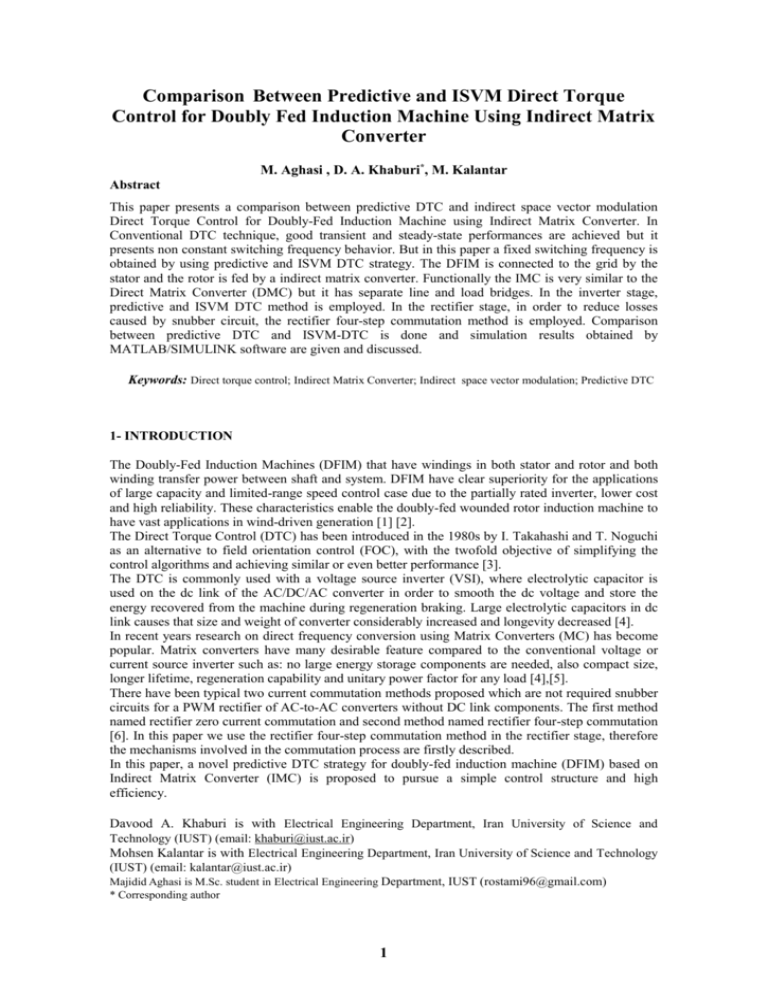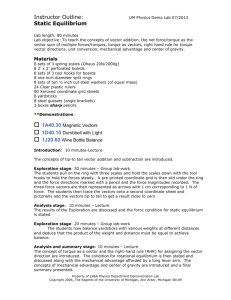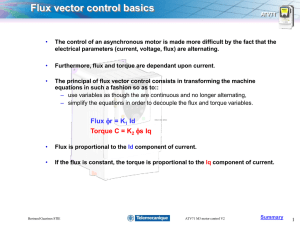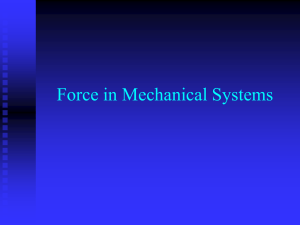Abstract - Iranian Journal of Electrical and Electronic Engineering
advertisement

Comparison Between Predictive and ISVM Direct Torque Control for Doubly Fed Induction Machine Using Indirect Matrix Converter M. Aghasi , D. A. Khaburi*, M. Kalantar Abstract This paper presents a comparison between predictive DTC and indirect space vector modulation Direct Torque Control for Doubly-Fed Induction Machine using Indirect Matrix Converter. In Conventional DTC technique, good transient and steady-state performances are achieved but it presents non constant switching frequency behavior. But in this paper a fixed switching frequency is obtained by using predictive and ISVM DTC strategy. The DFIM is connected to the grid by the stator and the rotor is fed by a indirect matrix converter. Functionally the IMC is very similar to the Direct Matrix Converter (DMC) but it has separate line and load bridges. In the inverter stage, predictive and ISVM DTC method is employed. In the rectifier stage, in order to reduce losses caused by snubber circuit, the rectifier four-step commutation method is employed. Comparison between predictive DTC and ISVM-DTC is done and simulation results obtained by MATLAB/SIMULINK software are given and discussed. Keywords: Direct torque control; Indirect Matrix Converter; Indirect space vector modulation; Predictive DTC 1- INTRODUCTION The Doubly-Fed Induction Machines (DFIM) that have windings in both stator and rotor and both winding transfer power between shaft and system. DFIM have clear superiority for the applications of large capacity and limited-range speed control case due to the partially rated inverter, lower cost and high reliability. These characteristics enable the doubly-fed wounded rotor induction machine to have vast applications in wind-driven generation [1] [2]. The Direct Torque Control (DTC) has been introduced in the 1980s by I. Takahashi and T. Noguchi as an alternative to field orientation control (FOC), with the twofold objective of simplifying the control algorithms and achieving similar or even better performance [3]. The DTC is commonly used with a voltage source inverter (VSI), where electrolytic capacitor is used on the dc link of the AC/DC/AC converter in order to smooth the dc voltage and store the energy recovered from the machine during regeneration braking. Large electrolytic capacitors in dc link causes that size and weight of converter considerably increased and longevity decreased [4]. In recent years research on direct frequency conversion using Matrix Converters (MC) has become popular. Matrix converters have many desirable feature compared to the conventional voltage or current source inverter such as: no large energy storage components are needed, also compact size, longer lifetime, regeneration capability and unitary power factor for any load [4],[5]. There have been typical two current commutation methods proposed which are not required snubber circuits for a PWM rectifier of AC-to-AC converters without DC link components. The first method named rectifier zero current commutation and second method named rectifier four-step commutation [6]. In this paper we use the rectifier four-step commutation method in the rectifier stage, therefore the mechanisms involved in the commutation process are firstly described. In this paper, a novel predictive DTC strategy for doubly-fed induction machine (DFIM) based on Indirect Matrix Converter (IMC) is proposed to pursue a simple control structure and high efficiency. Davood A. Khaburi is with Electrical Engineering Department, Iran University of Science and Technology (IUST) (email: khaburi@iust.ac.ir) Mohsen Kalantar is with Electrical Engineering Department, Iran University of Science and Technology (IUST) (email: kalantar@iust.ac.ir) Majidid Aghasi is M.Sc. student in Electrical Engineering Department, IUST (rostami96@gmail.com) * Corresponding author 1 The paper is organized as follows: in section II, a review of predictive DTC for doubly-fed induction machine is presented; then, in section III, the Indirect Matrix Converter (IMC) is introduced and its current commutation methods for rectifier stage (rectifier four-step commutation) is explained in section IV, in section V the predictive and ISVM DTC system based on IMC for doubly-fed induction machine is modeled and explained, simulation results for comparison between two model are available in section VI. Finally, the conclusions are exposed in section VII. 2- PREDICTIVE DIRECT TORQUE CONTROL FOR DFIM The block diagram of Predictive Direct Torque Control is depicted in fig 1. In this strategy the directly controlled variables are the electromagnetic torque and the rotor flux amplitude which are the same variables in conventional DTC method. As it can be seen from fig. 1, firstly by using the DFIM equations, the estimated torque, flux value and sector number of rotor flux are calculated. The estimated flux magnitude and torque are then compared with their respective desired values and the resulting value are fed into the two-level hysteresis comparators. the outputs of both flux and torque comparators together with the sector number of rotor flux, are used as inputs of the active vector selection block. Due to constant switching frequency in this predictive DTC control technique, switching period h is constant (h=1/f). There are two voltage vector. The first is active vector and in general, the second permitted vector will be a zero vector. At the beginning of each switching period, the control strategy calculates the optimum active vector required to maintain torque and flux near the reference value and reduce their ripples. This active vector by using the look up table is obtained. The look-up table is made up according to table 1. When the output of the comparator is set to 1, i.e. positive error, it means a positive slope variation is required. On the contrary, when the output is set to –1, i.e. negative error, a negative slope variation is needed. The portion of active vector in the sample period, with hc is shown. The typical torque and flux waveforms, for this control strategy are represented in Fig. 2. Considering the applied vector and the initial conditions at the current switching period, the slopes of the torque and flux variations can be calculated by using torque and flux derived equations [7],[8]. At each sample period, the slope of torque is called S1 if the active vector is applied, and is called S2 if the zero vector is applied. Similarly, S11 and S 22 are the slopes of the flux for the active and the zero vectors. During one sample period, the square of the square torque ripple is calculated as follows [7],[8]: 2 Tem ripple 1 hc 1 h ( s1.t Tem (k ) Tem _ ref ) 2 .dt ( s2 .t s2 .hc s1.hc Tem (k ) Tem _ ref ) 2 .dt 0 h h hc Fig. 1. Predictive DTC block diagram for DFIG 2 1 TABLE I. PREDICTIVE DTC SWITCHING TABLE S2 S1 Tem-ref Tem (k+1) Tem (k) Ψr (k) Ψr-ref Ψr (k+1) S11 hc S22 h Active Vector Zero Vector Fig. 2. Steady state Torque and Flux waveforms at motor and generator modes By deriving from last expression respect to the vector change instant hc , and equaling to zero, the minimum ripple torque is obtained. 2 dTem ripple dhc 0 (2) By solving this equation, the optimal switching instant hc is obtained as: hc 2.(Tem _ ref Tem (k )) s2 .hc 2.s1 s2 (3) 3- INDİRECT MATRİX CONVERTER Indirect Matrix Converter (IMC) is an AC/DC/AC converter, but bulky DC link capacitor is eliminated in it and a filter in entrance is used instead. Also, bi-directional switch in rectifier stage are used (see fig. 3). Because it has converter configuration with two separate stages (rectifier and inverter stages), it has been considered more flexible to modify its topology. Pulse width modulation algorithms of conventional inverters can be utilized in IMC, which can greatly simplifies its control circuit. Furthermore commutation problem of DMC are considerably reduced by using specific current Commutation methods [5],[6]. Regarding commutation strategies of IMC, two main rules should be taken into account: 1) The incoming and outgoing switches should not be switched on together at any point in time 2) Also these switches should not both be switched off at the same time in order prevent destroy the switches [4]. 3 Typically two types of commutations methods have been proposed which don’t require snubber circuits for a PWM rectifier of AC-to-AC converters without DC link components. The first method named rectifier zero current commutation and the second method named rectifier four-step commutation. In these methods, although the losses in snubber circuits and the switching losses in the PWM rectifier can be reduced, a complicated control circuit must be added to synchronize the switching of both the PWM rectifier and the PWM inverter [6]. In this paper four-step commutation method in the rectifier stage is used, therefore the mechanisms involved in the commutation process are firstly described. Figure 3. Indirect Matrix Converter 4- FOUR-STEP COMMUTATION STRATEGY The commutation process of matrix converter is more complicated compared with traditional ACDC-AC converter due to having no natural free-wheeling paths. Direction of output current and value of input voltage determine the sequence of switches that using four-step commutation strategy and commutation reliability depends on accuracy in detecting the direction of output current and two input-phase voltage differences [6]. The process of commutation is explained with Fig. 4. T AP and T BP are shown in Fig. 4. For example in this case the purpose is to show switching between phase A and B . phase A connects to rectifier output through IGBT of switch S11 and diode of switch S 12 . At this point, as it is shown (dotted lines in fig. 4.a) current does not pass from other transistors and diodes. It has been supposed that commutation begins from phase A to phase B . When i DC 0 the following four-step switching sequence is: 1) turn off S 12 ; 2) turn on S 31 ; 3) turn off S11 ; 4) turn on S 32 . When i DC 0 , the following four-step switching sequence is: 1)turn off S11 ; 2)turn on S 32 ; 3)turn off S 12 ; 4)turn on S 31 . Figure 4. Commutation from T AP to T BP 5- MODELING THE PREDICTIVE AND ISVM DTC BASED ON IMC FOR DFIM In this section the suggested model of Direct Torque Control based on Indirect Matrix Converter for doubly-fed induction machine is presented and analyzed. The fig. 5 shows the related diagram block. 4 As its shown, input voltages are sensed and along with torque and flux error and rotor flux sector are applied to control block. Input voltage with current direction in DC link are employed to determination mode of implementation of four-step commutation, that explained in detail in last section. An indirect space vector modulation (ISVM) is often used for matrix converters, providing full control of both the output voltage vector and the instantaneous input current displacement angle. The proportion between the two adjacent vectors gives the direction and the zero-vector duty-cycle determines the magnitude of the reference vector. A-Rectifier Stage The input voltage can be calculated using the following definition: Vi 2 2 ( va avb a vc ) 3 (4) Assuming that the displacement angle between the fundamental component of current and the input phase voltage is i , therefore Phase current vector angle can be achieved by a fictitious vector I x' as follows [9] [10]: I x' ix' ji y ' (5) In which: ix ' vx cos i v y sin i (6) i y v x sin i v y cos i ' The direction of I i is given by: I i arctan iy' 7 ix ' Fig. 6 shows that there are six active current space vector each of them is related to a certain switching configuration. As presented in Fig. 7 it is possible to obtain the input current vector by synthesize two adjacent fixed active vectors [10]: I i d i d i 8 Figure 5. Schematic diagram DTC based on IMC for DFIM 5 Where the relative duration of current vectors are: 9 d sin(60 i ) d sin i Figure 6. Input voltage and current vectors Figure 7. Synthesis of input current vector B- Inverter Stage The space vector of IMC output line-to-line voltage V oL L may be defined [9]: 2 VoL L ( )(v AB a vBC a 2 vCA ) 3 The output line-to-line voltage vector shown in Fig. 8. V 0L L 10 is synthesized by two adjacent fixed active vectors, as VoL L d v d v 11 Where the relative duration of voltage vectors are: 12 d sin(60 o ) d sin o d0 1 d d C - Two-Stage Matrix Converter To balance the input currents and the output voltages properly in the same switching period, the modulation pattern should combine the rectification and inversion vectors uniformly, producing the 6 following switching pattern: α γ-α δ-β γ-0. The combined duty-cycles of the rectification and inversion stages, using the previously presented switching pattern, are obtained as a cross product of their independent duty-cycles as shown in (15a), (15b), (15c) and (15d) [9]. d d d sin(60 o ) sin(i ) 13a d d d sin(o )sin(i ) 13b d d d sin(60 o ) sin(60 i ) 13c 13d d d d sin(o ) sin(60 i ) The zero-vector duty-cycle is determined as the complement of all active states combined. During the rest of the period all output phases are shorted and load voltage is zero, i.e. zero vector is taken: d0 1 d d d d 14 The switching pattern for an IMC is presented in Fig. 9. d ( ) and d 0 that shown in fig. 9 is given by [9]: 15 d ( ) (d d ). d d0 d0 d d .(1 (d d ).(d d )) 16 Figure 8. Synthesis of output voltage vector Rectifier stage commutation for predictive DTC and ISVM-DTC method is similar. Commutation differences occurs in the inverter stage. In inverter stage, predictive DTC expressed method in section II is used. So, commutation pattern for predictive DTC is as follow [11]. Figure 9. Switching pattern for ISVM DTC 7 γ δ h0 hz hz Hcγ hγ Figure 10. Switching pattern for predictive DTC 6- SIMULATION RESULTS In order to validate the justness of the proposed control strategy, the developed control system, shown in Fig. 5, is implemented in MATLAB/SIMULINK. The machine parameters are provided by Matlab 7.8 as follows: 250V stator line-line voltage, PN 15kW , f 50Hz , the results of torque control for both predictive DTC and the ISVM method are presented in Fig.11. As it can be seen, the predictive method leads to less deviation from the set value of torque rather than the ISVM DTC. a b Figure 11. Torque response: (a) predictive DTC (b) ISVM-DTC Fig. 12 shows the flux response for this two method. Fig. 13 shows the flux circular trajectory for both predictive DTC and the ISVM method. It is obvious that predictive method can improve steady and dynamic performance of the system and decrease unreasonable flux ripple. Fig.14 shows rotor current and stator current respectively. Also, Fig.15 and Fig.16 shows rotor flux sector and DC link voltage of IMC respectively. In Fig.17 ratio of active vector to zero vector (hc/h) is shown witch obtain by Eq.7 and 8. The advantage of predictive method compared with ISVM clearly shows in table II. As can be seen, predictive method can improved machine behavior extraordinary. a 8 b Figure 12. Rotor flux response (a) predictive DTC (b) ISVM-DTC a b Figure 13. Flux circular trajectory (a) predictive DTC (b) ISVM DTC a b Figure 14. Current waveform for predictive method (a) Rotor (b) Stator 9 Figure 15. Rotor flux sector Figure 16. DC link voltage of IMC Figure 17. Ratio of active vector to zero vector (hc/h) TABLE II. comparition between predictive and ISVM DTC 7- CONCLUSION Simulation results show the capacity of this new predictive DTC technique with indirect matrix converter, to control the torque and the flux of the DFIM at constant switching frequency. Compared with ISVM-DTC, ripple reduction of torque and flux in predictive DTC method is more. Both method also presents good tracking behavior, capable of working at variable speed operation conditions for both motoring and generating modes. However, simulation results show that predictive method is more suitable for use in applications such as wind power generation. Beside the improvments of the proposed method, using indirect matrix converter as static converter in this project, the advantages of this converter ( such as small size, near sinusoidal input current and long life-time) is also increased performance of model. Doubly-fed induction generator is used extensively in wind power plant to generate energy. To reduce problems of converter, snubber circuits were excluded from the converter and Four-step commutation strategy was used instead. In order to verify the predictive method, a Simulation task is prepared in SIMULINK/MATLAB software enviroment the obtained results confirm the superiority of the predictive method. 8- REFERENCES [1] Z. Liu, O.A. Mohammed, S. Liu; “A Novel Direct Torque Control of Doubly-Fed Induction Generator Used for Variable Speed Wind Power Generation,’’ IEEE Power Engineering Society General Meeting, 2007. pp: 1 – 6. 10 [2] [3] [4] [5] [6] [7] [8] [9] [10] [11] [12] O.A. Mohammed, Z. Liu, S. Liu; “Stator power factor adjustable direct torque control of doubly-fed induction machines,’’ IEEE International Conference on Electric Machines and Drives, 2005. pp: 572 – 578. I. Takahashi and T. Noguchi, “A new quick-response and high efficiency control strategy of an induction motor,” IEEE Trans. Ind. Appl., vol. IA-22, no. 5, pp. 820–827, Sep./Oct. 1986. P.W. Wheeler, J. Rodriguez, J.C. Clare, L. Empringham, A. Weinstein; “Matrix converters: a technology review,” IEEE Transactions on Industrial Electronics, Vol. 49, Issue 2, Apr 2002 pp. 276 – 288. L. Wei, T. A. Lipo, “A novel matrix converter topology with simple commutation,’’ Industry Applications Conference, 2001. Vol.3, pp: 1749 – 1754. M. X. he; T. G. jun; W. X. Ian; F. Y. li; Z. Xiao; H. Y. fei; “Research on Improved Four-step Commutation Strategy of Matrix Converter Based on Two Line Voltage Synthesis’’ Second International Conference on Innovative Computing, Information and Control, ICICIC '07 , pp: 503 – 503, 2007 G. Abad; M.A Rodriguez; J. Poza; “Two-Level VSC Based Predictive Direct Torque Control of the Doubly Fed Induction Machine With Reduced Torque and Flux Ripples at Low Constant Switching Frequency, ‘’ IEEE Transactions on Power Electronics, Volume: 23 , Issue: 3, 2008 , Page(s): 1050 - 1061 G. Abad; M.A Rodriguez; J. Poza;“ Predictive Direct Torque Control of the Doubly Fed Induction Machine with Reduced Torque and Flux Ripples at Low Constant Switching Frequency, ‘’ IEEE Industrial Electronics, IECON 2006, Page(s): 1000 – 1005 K. Iimori; K. Shinohara; K. Yamamoto; “A study of dead-time of PWM rectifier of voltagesource inverter without DC link components and its operating characteristics of induction motor,’’ Industry Applications Conference, 2004. vol.3, pp: 1638 – 1645. X. Chen, M. Kazerani; “A New Direct Torque Control Strategy for Induction Machine Based on Indirect Matrix Converter,’’ IEEE International Symposium on Industrial Electronics, Vol.3, pp: 2479 - 2484 July 9-12, 2006 M. Aghasi, V. Faraji; D. A. Khaburi, M. Kalantar “Direct Power Control for Doubly-Fed Induction Generator Using Indirect Matrix Converters,’’ 25th International Power System Conference, Nov 8-10, 2010 V. Faraji, M. Aghasi, D. A. Khaburi, M. J. Ghorbani,"A Modified DTC for Induction Motor Drive System Fed by Indirect Matrix Converter Using Active Learning Method," 2st Power Electronic and Drive Systems and Technologies Conf., Feb. 2011. 11






